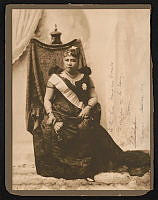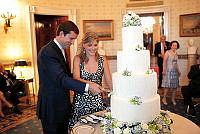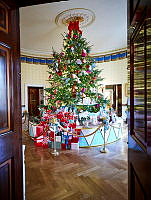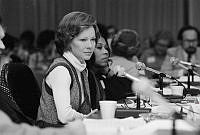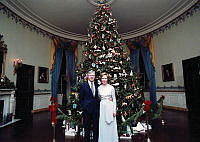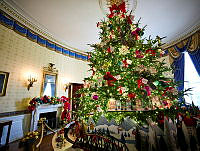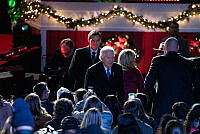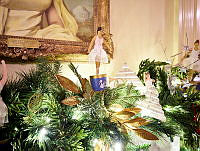Sarah Polk

Sarah Childress was born to Joel and Elizabeth Childress on September 4, 1803, in Tennessee.1 Her father was a wealthy plantation owner, which led to a privileged upbringing for Sarah and her siblings. She was well educated, studying at Abercrombie’s Boarding School in Nashville and the Moravian Female Academy in Salem, North Carolina.2
Sarah’s father was involved in Tennessee politics and she often spent time around powerful men. Sarah married lawyer and up-and-coming politician James K. Polk on January 1, 1824.3 The two never had children.4 As newlyweds, they lived in the Polk family home in Columbia, Tennessee, but later relocated to Nashville.
In the years that followed, James Polk embarked on a political path with Sarah as his partner.5 Sarah played an active role in his congressional, gubernatorial, and presidential campaigns, foreshadowing the influential role she went on to play as first lady.
At the White House, Sarah Polk served as confidante, informal advisor and secretary to President Polk, making her a powerful first lady ahead of her time. Behind closed doors, Mrs. Polk met and negotiated with politicians, stayed abreast of developments in the news, and supported and guided her husband’s policies, especially regarding Manifest Destiny and the Mexican-American War.6 She also managed enslaved and free laborers at the Executive Mansion, as well as at their Yalobusha, Mississippi plantation and Polk Place, their Tennessee estate.7
Publicly, Sarah Polk embodied the demure, domestic ideals of nineteenth-century femininity to the American people, and she was a very popular first lady. The White House underwent major changes during Mrs. Polk’s residency; for example, the Red Room became red for the first time in history, and gas lighting was installed at the Executive Mansion.8
Sarah hosted weekly receptions at the White House and was a devoted wife, hostess, and Presbyterian. Her religious devotion led her to ban hard liquor and dancing at the White House.9 In maintaining and projecting these ideals of womanhood and domesticity, Mrs. Polk could participate in politics privately.10
James K. Polk died from cholera only three months after his presidency ended in June 1849, leaving Sarah a widow and sole manager of Polk Place and their Mississippi plantation, as well as over fifty enslaved people. Sarah also championed the late president’s legacy, maintaining his papers and entertaining other politicians at Polk Place. She refused to leave Nashville at the outbreak of the Civil War, and her home remained neutral territory. Sarah Polk died on August 14, 1891, at the age of eighty-seven. She is buried with her husband on the grounds of the Tennessee State Capitol.
Click here to learn more about the enslaved households of the Polk family.
Footnotes & Resources
- According to historian Amy Greenberg, there is no evidence to indicate the Sarah was born in Murfreesboro, although Sarah and many historians afterward have claimed this to be so. Amy S. Greenberg, Lady First: The World of First Lady Sarah Polk (New York: Alfred A. Knopf, 2019).; Jane Crumpler DeFiore, “Sarah Childress Polk,” Tennessee Encyclopedia, Tennessee Historical Society, https://tennesseeencyclopedia.net/entries/sarah-childress-polk/.
- “History of Sarah Childress,” President James K. Polk Home and Museum, https://jameskpolk.com/history/sarah-polk/.
- Teri Finneman, “A First Lady, a Funeral, A Legacy,” in Southern First Ladies: Culture and Place in White House History Ed. Katherine A. Sibley (Lawrence, KS: University of Kansas Press, 2020), 93.
- “James K. Polk,” White House Historical Association, https://www.whitehousehistory.org/bios/james-polk.
- Amy S. Greenberg, Lady First: The World of First Lady Sarah Polk (New York: Alfred A. Knopf, 2019).
- Amy S. Greenberg, Lady First: The World of First Lady Sarah Polk (New York: Alfred A. Knopf, 2019).
- See Lina Mann, “The Enslaved Households of President James K. Polk,” White House Historical Association, https://www.whitehousehistory.org/the-enslaved-households-of-james-k-polk; Zacharie W. Kinslow, ”Plantations and Politics,” White House Historical Association, https://www.whitehousehistory.org/plantations-politics.
- Matthew Costello, “The Red Room in the Polk White House,” White House Historical Association, https://www.whitehousehistory.org/the-red-room-in-the-polk-white-house.
- Conover Hunt, “Fashion and Frugality,” White House Historical Association, https://www.whitehousehistory.org/fashion-and-frugality.
- Anna Diamond, “How First Lady Sarah Polk Set a Model for Conservative Female Power,” Smithsonian Magazine, February 4, 2019, https://www.smithsonianmag.com/history/how-first-lady-sarah-polk-set-model-conservative-female-power-180971393/.













